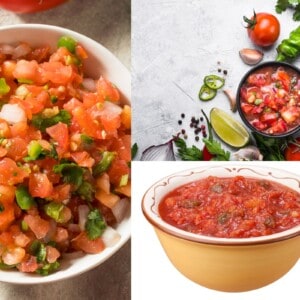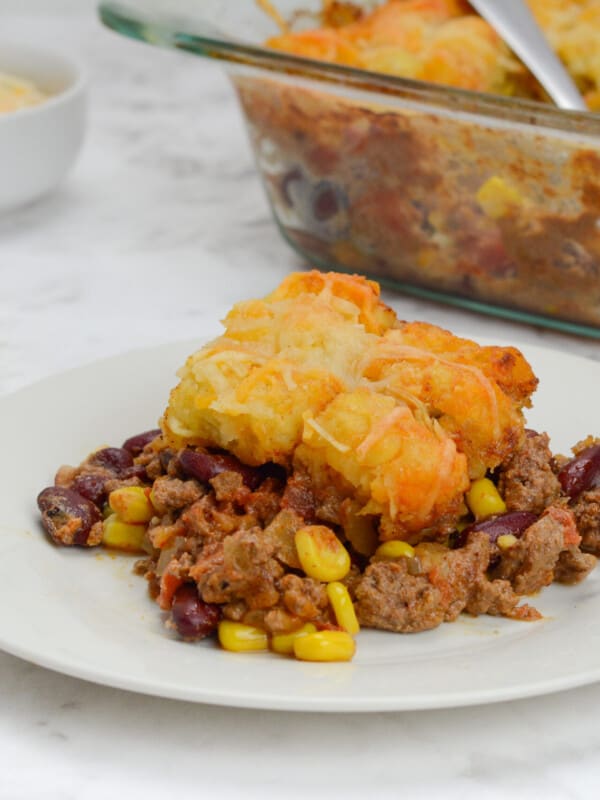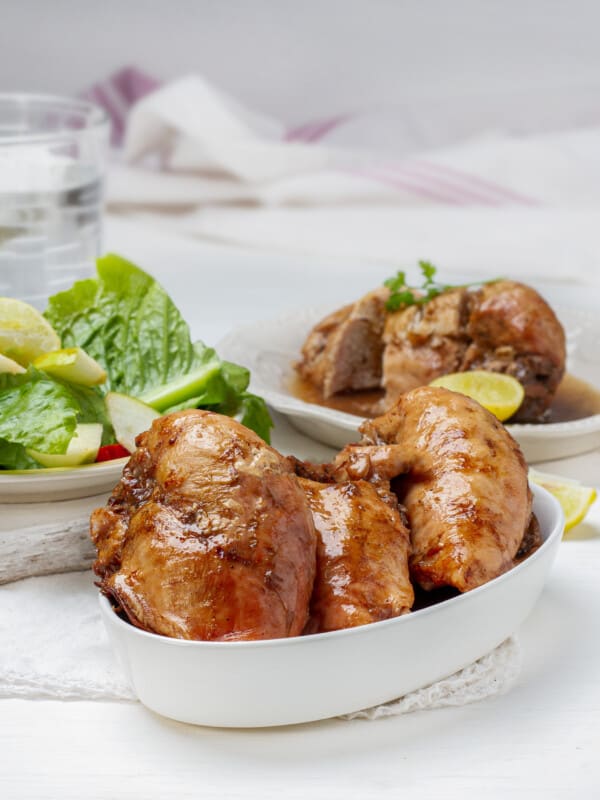Pico de gallo and salsa are both popular additions to Mexican meals, both can be a snack on their own, and both have similar ingredients and preparation. A lot of people might be confused what the differences are between the two, and why both exist.
Fortunately, there are a lot of reasons salsa and pico de gallo are considered different things, and why we get to enjoy both of them in our meals today!
Here are the core differences, and some delicious recipes so you can make both sauces at home!
| Pico de Gallo | Salsa | |
| Origins | Roots in Aztec cuisine, considered Mexican. | Made by Aztecs, Incas, and Mayans |
| Ingredients | Tomatoes, onions, chilies, lime juice, and other ingredients | Tomatoes, onions, chilies, lime juice, and other ingredients |
| Preparation | Chopped fresh and combined | Chopped, combined, and cooked, often before being canned for preservation. |
| Serving | Served fresh, usually within a few hours of making. | Served cold, after being cooked and then chilled, and sometimes blended. |
What is Pico de Gallo
Pico de gallo, sometimes also called salsa fresca, is a chopped salad or sauce (depending on your definition and how fine you chop the vegetables) that is commonly served as a topping on Mexican dishes, and sometimes eaten as a snack or an appetizer with tortilla chips.
Made from tomatoes, onions, chilies, limes, and occasionally other ingredients like beans or corn, pico de gallo is light, flavorful, often spicey, and always delicious.
It’s also incredibly light on calories and high in nutrients, making it a fantastic addition to your regular diet.
Different Types of Pico de Gallo
Pico de gallo has a lot of different variations, but most of them come down to differences in recipes rather than fully different versions of the dish. Typically pico de gallo is a combination of red, white, and green vegetable colors, which just so happens to be the same colors as the Mexican flag.
But you can also made different versions by omitting some of the ingredients, or adding extras like strawberries or mango.
In fact, just about any kind of vegetables or fruits that are tasty cold can be added to pico de gallo.
How Do You Make Pico de Gallo?
The trick to making good pico is twofold. The first step is getting everything chopped into roughly equal sizes. Chilis can sometimes be smaller than the rest of the vegetables, in order to make sure the spice level isn’t overwhelming, but other ingredients should be about equal size.
The next is figuring out how much acid you want to add and how long you should let the pico de gallo marinate before serving. Acid usually comes from the vegetables as well as the lime juice added to the mix. However, vinegar, or lemon juice are alternatives if lime juice isn’t available.
Marinating time is critical since the longer the dish marinates the more the flavors will blend together. Some people prefer their pico de gallo made entirely fresh, while others like to make theirs a day or two in advance of serving.
Salt also helps bring out the different flavors of the dish, and can help make it taste more balanced and slightly less acidic, without completely eliminating the acids.
Delicious Pico de Gallo Ingredients
Pico de gallo is almost always based on the combination of four things, with other ingredients working to change the flavor or make for a sweeter or more savory version of the dish.
The key four ingredients are:
- Tomatoes
- Chilies
- Onions
- Lime juice
Most recipes also call for a small amount of salt to help bring out the other flavors of the dish, but not all of them do.
Other ingredient options include beans, corn, mango, strawberries, apple, cucumbers, watermelon, avocado, cilantro, fresh garlic or garlic powder, and other fresh vegetables.
The core of this dish is that everything is fresh and uncooked. Minimal processing and getting the ingredients as fresh and ripe as possible can make for a more flavorful version of the dish.
Great Pico de Gallo Recipes You Should Try
If you’re looking for a great pico de gallo recipe, there are a lot of options out there. Different people debate what kinds of tomatoes, chilis and even onions are best for making pico de gallo. Some require cilantro, while other recipes think that cilantro and other seasonings are more of an optional garnish rather than a requirement.
Delish has a fantastic recipe for a classic, minimally customized pico de gallo. This recipe is a great base for other variations as well.
Want a chunkier version that will impress guests with fresh ingredients and home-made flair? Allrecipes’ take on pico de gallo might just be the one for you.
What Is Salsa?
Salsa is incredibly similar to pico de gallo, and can be made with the same ingredients, but it can also be a lot more varied and complex than your standard pico de gallo. For one thing, salsa is almost always cooked, and often blended, which leads to different flavors and textures than typical pico de gallo.
Since this dish is cooked, you can also choose from a wider range of vegetables and fruits, since you don’t have to worry about the flavor and texture fresh. All you need to worry about are the flavors the cooked ingredient brings to the dish, and how well it will can for long term storage.
Different Styles Of Salsa
There are a lot of different styles of salsa, mostly depending on whether you use a tomato base or not, what chilies are used, and whether you include any fruit in the blend. Here are a few examples to consider:
- Salsa Verde: Salsa verde doesn’t typically use tomatoes, replacing them with green tomatillos, which have a different slightly more savory flavor, more tangy and acidic. Tomatillos are usually roasted, and then blended with raw or roasted onions, jalapenos, poblanos, or serrano peppers, or a combination of the three.
- Salsa Roja: Salsa roja refers to any salsa made with tomatoes, which gives the salsa a predominantly red color. Classic salsa roja is blended or ground into a fine paste, but that step is optional.
- Fruit Salsa: Fruit salsas are often milder and designed to be sweeter, often more refreshing. However, that isn’t always true, and sometimes fruit can be added to a spicier salsa to help balance the heat. Common fruits include strawberries, citrus fruits, mango, raspberries, blackberries, pineapple, and others.
Some salsas are also fermented to give them a different flavor, or to help preserve them without canning or refrigeration.
How Do You Make Salsa?
Salsa starts basically the same as pico de gallo, with chopping up ingredients to combine them. Some salsas call for an optional roasting step before you chop them, which can make a smokey more savory flavor in the salsa.
From there, you can boil the ingredients together, which prepares the salsa for canning and preservation. Boiling the ingredients blends the flavor and helps give you a better final texture to your salsa.
If you have a water bath canner or a pressure canner you can fill jars with the salsa and can it for long term storage. Otherwise, you can store in any container in the refrigerator for several days at a time, sometimes longer depending on your ingredients.
Some salsas call for raw ingredients to be added after boiling, especially fruit ingredients. That can help preserve their original flavor and texture, while the flavors will spread in storage. Adding raw ingredients often makes the salsa go bad faster if you don’t can it afterward. The canning process will cook any raw ingredients added before canning.
Salsa Ingredients To Experiment With
There are a lot of different potential ingredients you can play with when you’re making salsa. Like pico de gallo, one of the big tricks of getting your salsa right is getting the right proportion and combination of ingredients nailed down.
There are thousands of possible recipes for salsa, so don’t worry too much about experimenting with it. There are a lot of different ways to get salsa right. Tomatoes, jalapenos, serrano, poblano, bell peppers, onions, lime juice, salt, sugar, mango, strawberries, kiwi, raspberries, habanero, blackberries, apple, and other ingredients.
Top Salsa Recipes You’re Sure To Love
If you’re looking to replicate the delicious salsas you get at restaurants, Food Network has a good recipe for restaurant-style salsa you can enjoy in the comfort of your home.
Want to try your hand at salsa verde, Simply Recipes has a delicious tomatillo based salsa verde recipe.
Wrapping Up: What are the key differences between Salsa and Pico de Gallo?
There are a lot of small differences between salsa and pico de gallo worth considering when you’re figuring out which one you want to make and which one you want to keep around. Here are some of the key differences between these foods:
- Salsa comes in a wider range of varieties, thanks to the added versatility of cooking the ingredients.
- Both pico and salsa use chopped vegetables as a base, but pico usually leaves them chopped, while salsa often blends them together or boils them to a different consistency.
- Pico de gallo usually has a more limited ingredients list than salsa, while salsa can have a lot more ingredients as long as they are well balanced.
- Pico de gallo is always raw, salsa is almost always cooked.
Frequently Asked Questions (FAQs)
Q1: Which is healthier, salsa or pico de gallo?
Pico de gallo is generally considered healthier since it isn’t cooked so the raw nutrients in the sauce aren’t altered. However, salsa has a lot of the same nutrition, just partially processed. Cooking can also make other nutrients more bio-available, so it really comes down to the specific ingredients you use and the details of the preparation.
Q2: Is salsa just cooked pico de gallo?
No. While salsas can be made by cooking pico de gallo, there are a lot of other ways to make salsa, which helps make them more distinct.
Q3: Do you always need to blend salsa?
No. While it’s common to blend salsa, it’s not a requirement. Fine chopping can do basically the same job, while rougher chopped salsa can feel more rustic to suit other kinds of meals better.
Pico de Gallo vs Salsa

Instructions
- choose your favorite recipe
- click the link to view the recipe instructions
- follow the linked instructions
- enjoy!





